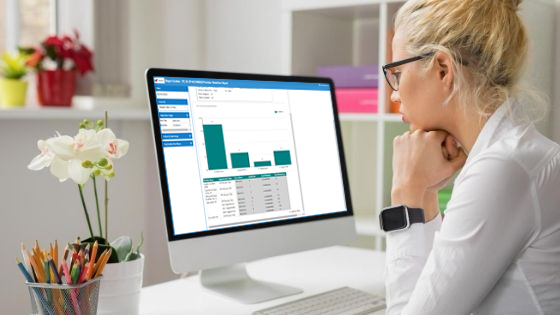The most common comment we hear at Valant is “I had phenomenal clinical training but the one class I was never taught in graduate or medical school was How to Run my Practice.”
What we have realized is that the cornerstone of running and managing a practice is having proper access to information that will help guide an end-user to clinical and financial success. At Valant, we have inventoried what categories of business and clinical management would be most helpful to business owners and managers to best run their practice.
Data. Data is the answer. When behavioral health practices improve their business reporting, their practices thrive. But from the feedback that we’ve received, we know that if the data is not presented in a way that is digestible and can properly be consumed by the end user – then it’s not helpful.
We have responded by building out several layers of user-friendly reporting tools that help Valant customers report, with ease, on critical areas of their business. This, ultimately, helps our customers make the most informed business and clinical decisions for their practice.
Business need: A simple, macro-level overview for how my mental health practice is operating
Valant Reporting Solution: System Reports
System Reports are not new to Valant. They have been, and continue to be, an integral part of the platform, giving practices high-level visibility into many different parts of their business.
Some of the most popular system reports behavioral health practices like to use are:
- Productivity (time and $) by Provider
- Status of clinical documentation for billed appointments
- Account Receivable – both insurance and patient
- Insurance/Patient Aging Reporting
- Provider case loads
- Authorizations
- Patient Activity – which active patients have not been seen for what amount of time
- Revenue per CPT Code by Payer
Business need: More detailed, micro-level analysis on different aspects of my practice
Valant Reporting Solution: Report Center
Valant Report Center gives practices deeper, more customizable reporting to help them achieve their business goals. While Report Center is not entirely new to Valant, we added some significant improvements recently, including a robust library of new, powerful reports.
See the difference between Valant System Reports and Valant Report Center.
Some of the most popular reports behavioral health practices like to use within Report Center are:
- Provider Productivity Report: Month-over-month analysis to see if providers are trending in the best clinical and financial direction for the practice. Identify which month trends were interrupted to then identify why and what solutions need to be implemented to remedy.
- Productivity Benchmarking Report: Are there weekly, monthly, quarterly, annual productivity goals that your providers need to meet in order to keep your budget in good standing? Valant’s Productivity Benchmarking Report allows for managers to enter productivity expectations for one provider or a cohort of providers and will graphically show how well each provider has or has not met expectations. This allows managers to make professional development or marketing decisions accordingly.
- Aggregate Outcome Measure Report: This report gives practices the tools and ammunition needed to have successful negotiations with insurance companies to achieve higher reimbursement rates or value-based care contracts.
- Provider Retention Report: Are certain providers churning intakes more than others? Is rapport an issue with certain clinicians and their clients? This report enables granular analysis of how well clinicians are retaining their clients, unveiling if there are retention issues based on various diagnostic categories, payer categories or programming. With this data, clinical supervisors can isolate where clinicians may need additional clinical development to better meet the needs of their clients. It may also help them decide which providers to pair with different types of incoming referrals.
Want to see how easy it is to generate these reports? Click here to watch our Report Center demonstration videos.
Business need: Reporting on custom fields that are important to my behavioral health practice
Valant Reporting Solution: Export Center
Export Center, another arm of the Valant reporting platform, allows end users to create their own custom demographic fields that then can be aggregated for reporting purposes. While this may sound daunting, like something only a data informatics analyst would attempt, it is actually quite easy and has proven to be an extremely valuable tool for many practices.
Some of the most popular ways behavioral health practices are using Valant Export Center include:
- Intake questionnaires: When a client first calls in, you can capture many reportable and structured data points that may be helpful for intake managers and owners of a practice to analyze in aggregate.
- Frequency of referrals for various diagnostic categories: A practice may specialize in treating various diagnostic categories such as depression, anxiety, or obsessive-compulsive disorder. However, if a practice is considering expanding, it’s helpful to know what other diagnostic categories are in demand. Using Valant’s custom fields, you can define what other treatment areas you would like to track, allowing you to make informed hiring decision tailored to the market’s needs. For example, if you have received 30+ requests for treating trichotillomania, A) it’s helpful to know and B) it might be time to start a trich program and hire a specialist to capitalize on the market demand for such programming.
- Frequency of referrals for various treatment modalities: A practice may also specialize in various treatment modalities such as CBT, DBT, ACT or Psychoanalysis. However, if there is a high demand for certain treatment modalities that you don’t provide, A) it’s helpful to know and B) it might be time to start programming around that treatment protocol.
- Types of referral sources: Who is actually sending clients your way? If you can determine that there are categories of referral sources that are not referring clients, you can develop targeted marketing campaigns towards that specific population. For example, pulling aggregate data illustrating that inpatient units have not referred clients to your practice for the last 6 months, should help you become laser-focused on developing a tailored marketing strategy to that demographic.
- Zip codes of referral sources: What zip codes are – or just as importantly, are not – referring? With this data, you can build a targeted marketing plan around that specific territory.
Business reporting for behavioral health practices: What does good look like?
Like any other type of business, mental health practices should have at least a basic level of reporting in place that gives them full visibility into the inner-workings of their practice and a line of sight to important KPIs. Without this, it is difficult, maybe even impossible, to make sound business decisions that will keep them profitable.
Beyond analyzing the basic business metrics, a robust set of reporting capabilities is critical to help private practices achieve the following benefits:
- Provide better care over time
- Negotiate better rates with payors
- Improve their provider productivity
- Build better marketing programs
What problems do owners face when it comes to getting the data they need to manage their practice?
While, intuitively, most practice managers understand the value of good reporting, there are several primary reasons why practices continue to fall short in this department:
- Inexperience running a business: Many providers open their practice and provide amazing clinical care, but they aren’t as savvy about the business side of things. They don’t know what they don’t know. They don’t realize these types of insights are available for their practice, especially if they don’t know where to look.
- Still using paper: When practice data is not stored electronically, in most cases, business reporting is simply not possible.
- Their EHR makes it too difficult: Most EHR and practice management platforms think about reporting as an after-thought, if at all. Because of this, creating helpful reports is cumbersome, time-consuming, and manual. It sometimes requires a specialized data analyst to extract data the right way, interpret the reports, and find the insights.
Fortunately, Valant is here to help! From practice management guidance to best-in-class EHR technology, Valant’s EHR software for behavioral health provides the tools you need to generate helpful reports that can transform your practice.
Here are some of the highlights that make Valant’s reporting platform stand out:
- It pulls all the data directly from the EHR. The detailed data is already there and is quite robust. Report Center is powerful enough to do the hard work of crunching through it and presenting it in a way that you can glean actionable insights from it.
- It’s easy to use. With Valant’s intuitive and user-friendly interface, anyone within your organization can feel confident producing useful reports.
- It gives you ultimate flexibility. Create custom fields or use out-of-the-box filters to dig into the data in a way that’s most useful for your practice.
- It’s specific to Behavioral Health. Why is that important? When you’re using an EHR that is not behavioral-health specific, you have to wade through a lot of clutter, both in terms of data input, as well as reporting filters. Many times, you may have to fill out mandatory patient fields that are geared toward physical health or other specialties, but irrelevant for mental health (for example, A1c test data or last menstrual cycle). Those fields also become a burden on your reporting. Valant eliminates a good portion of that recreational data by focusing just on the fields that are useful to practices within behavioral health.
See for yourself
Would your practice benefit from better business reporting? We would love to talk with you about your practice goals and show you how our reporting platform works.




